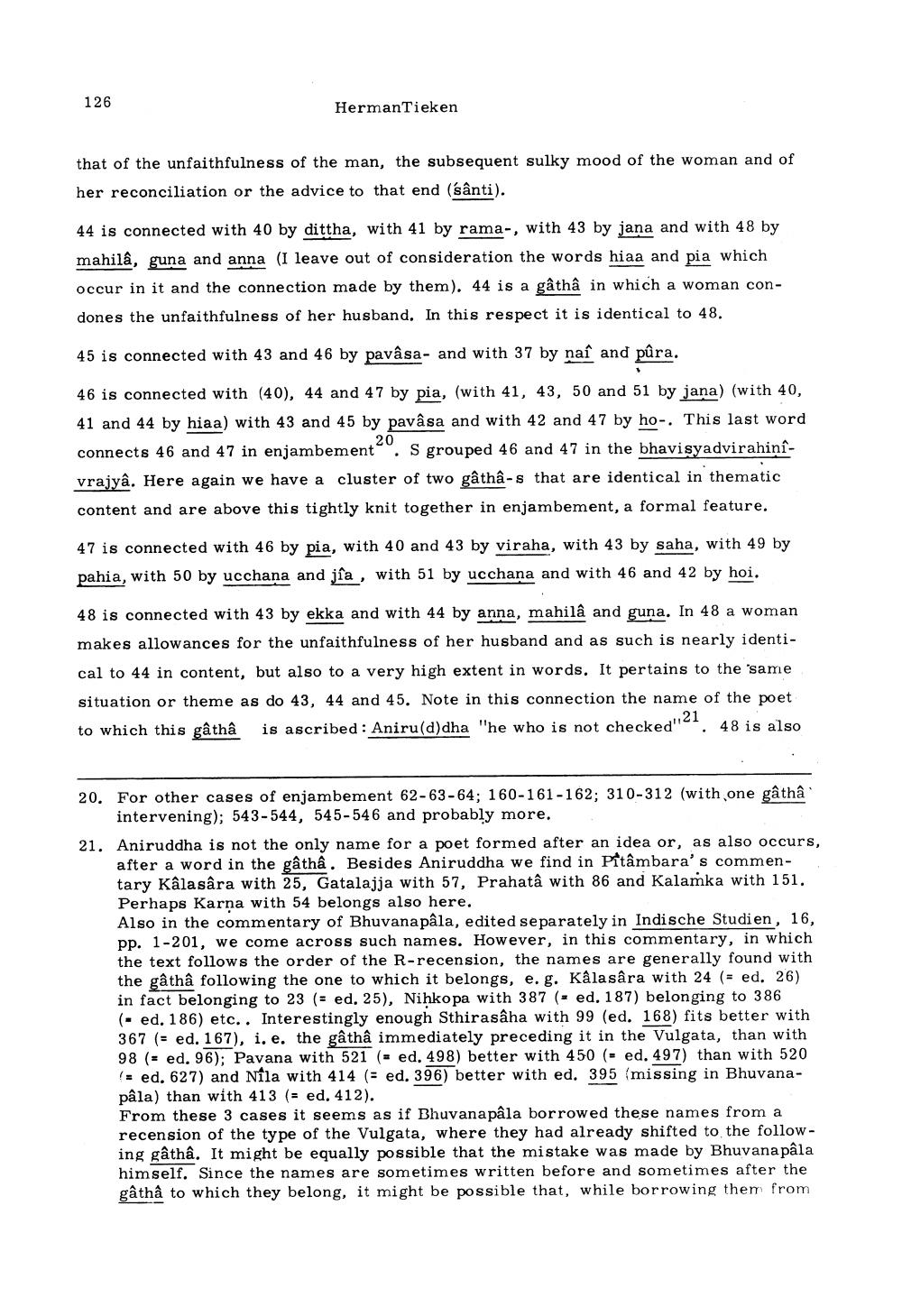________________
126
HermanTieken
that of the unfaithfulness of the man, the subsequent sulky mood of the woman and of her reconciliation or the advice to that end (sânti).
44 is connected with 40 by dittha, with 41 by rama-, with 43 by jana and with 48 by mahilâ, guna and anna (I leave out of consideration the words hiaa and pia which occur in it and the connection made by them). 44 is a gâthâ in which a woman condones the unfaithfulness of her husband. In this respect it is identical to 48.
45 is connected with 43 and 46 by pavâsa- and with 37 by naî and pûra.
"
46 is connected with (40), 44 and 47 by pia, (with 41, 43, 50 and 51 by jana) (with 40, 41 and 44 by hiaa) with 43 and 45 by pavâsa and with 42 and 47 by ho-. This last word 20 connects 46 and 47 in enjambement. S grouped 46 and 47 in the bhavisyadvirahinîvrajyâ. Here again we have a cluster of two gâthâ-s that are identical in thematic content and are above this tightly knit together in enjambement, a formal feature.
47 is connected with 46 by pia, with 40 and 43 by viraha, with 43 by saha, with 49 by pahia, with 50 by ucchana and jîa, with 51 by ucchana and with 46 and 42 by hoi.
48 is connected with 43 by ekka and with 44 by anna, mahilâ and guna. In 48 a woman makes allowances for the unfaithfulness of her husband and as such is nearly identical to 44 in content, but also to a very high extent in words. It pertains to the same situation or theme as do 43, 44 and 45. Note in this connection the name of the poet
to which this gâthâ is ascribed: Aniru (d) dha "he who is not checked"21 48 is also
20. For other cases of enjambement 62-63-64; 160-161-162; 310-312 (with one gâthâ intervening); 543-544, 545-546 and probably more.
21. Aniruddha is not the only name for a poet formed after an idea or, as also occurs, after a word in the gâthâ. Besides Aniruddha we find in Pitâmbara's commentary Kâlasâra with 25, Gatalajja with 57, Prahatâ with 86 and Kalamka with 151. Perhaps Karna with 54 belongs also here.
Also in the commentary of Bhuvanapâla, edited separately in Indische Studien, 16, pp. 1-201, we come across such names. However, in this commentary, in which the text follows the order of the R-recension, the names are generally found with the gâthâ following the one to which it belongs, e. g. Kâlasâra with 24 (= ed. 26) in fact belonging to 23 (= ed. 25), Nihko pa with 387 (= ed. 187) belonging to 386 (ed. 186) etc.. Interestingly enough Sthirasâha with 99 (ed. 168) fits better with 367 (= ed. 167), i. e. the gâthâ immediately preceding it in the Vulgata, than with 98( ed. 96); Pavana with 521 (= ed. 498) better with 450 (= ed. 497) than with 520 (= ed. 627) and Nila with 414 (= ed. 396) better with ed. 395 (missing in Bhuvanapâla) than with 413 (= ed. 412).
From these 3 cases it seems as if Bhuvanapâla borrowed these names from a recension of the type of the Vulgata, where they had already shifted to the following gâthâ. It might be equally possible that the mistake was made by Bhuvana pâla himself. Since the names are sometimes written before and sometimes after the gâthâ to which they belong, it might be possible that, while borrowing them from




